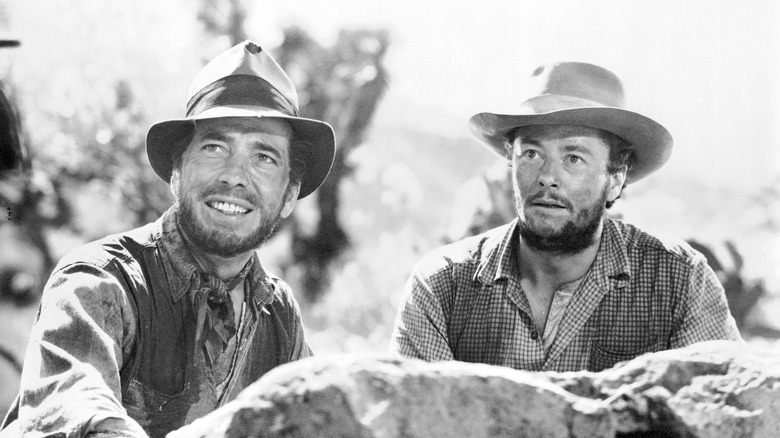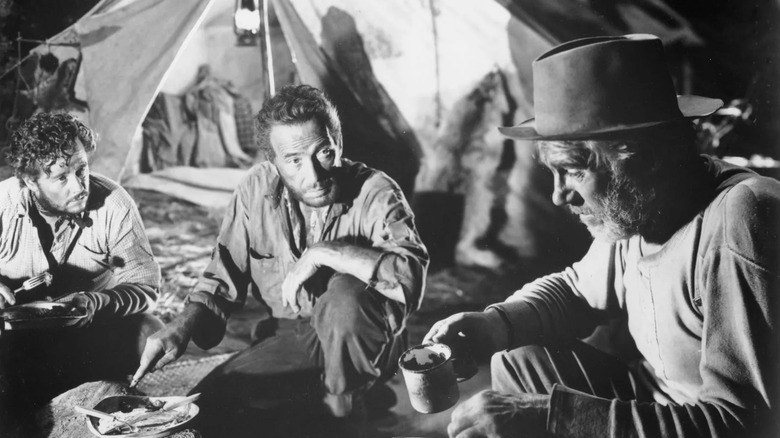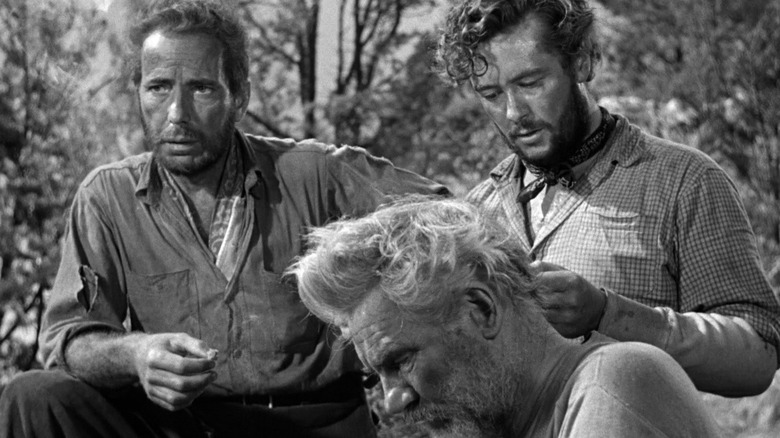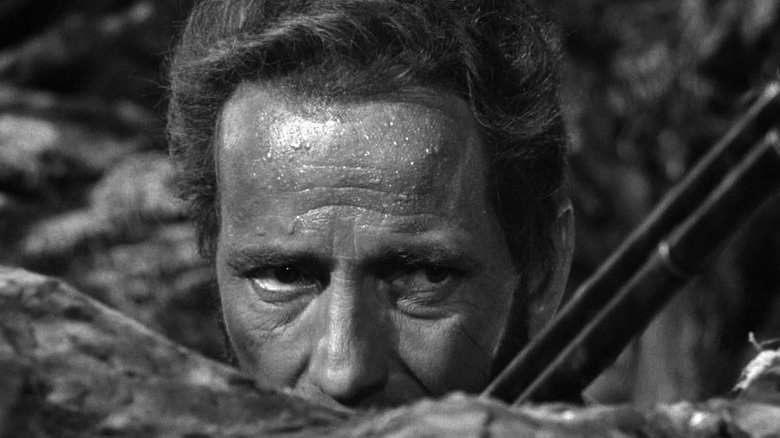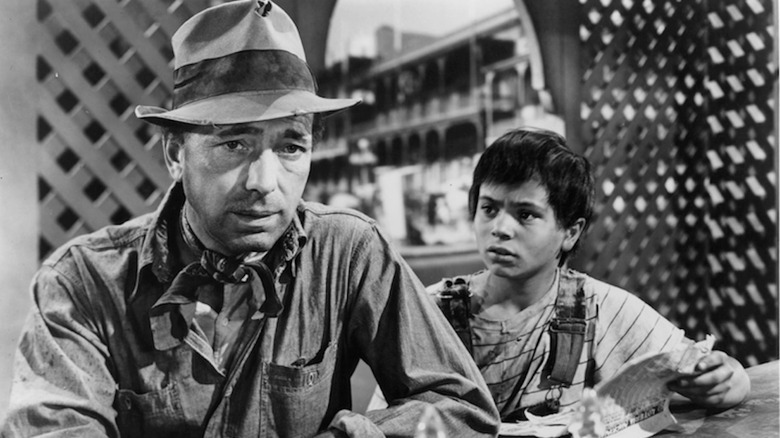John Huston Was Unraveling A Real-Life Mystery On The Treasure Of The Sierra Madre Set
Long before Martin Scorsese and Robert DeNiro, or Wes Anderson and Bill Murray, John Huston and Humphrey Bogart were one of the great director-actor combos of Hollywood's Golden Age. Their first collaboration, "The Maltese Falcon," gave the actor his big breakthrough and one of his defining roles as the cynical private eye, Sam Spade.
It made Bogart a star and five more films followed, with the partnership resulting in Bogie's only Oscar win, playing a booze-soaked riverboat captain in "The African Queen." In between, it was Huston's turn; he picked up the only Academy Awards of his long career for Best Director and Best Screenplay for "The Treasure of the Sierra Madre," often regarded as the duo's best film and Huston's masterpiece.
Adapted from the novel by B. Traven, "Sierre Madre" is a riveting study of greed, following three down-on-their-luck Americans in search of gold in Mexico. When they strike rich, the avaricious Fred Dobbs (Bogart) becomes murderously paranoid about the others stealing his stash. If "The Maltese Falcon" helped establish Bogart's world-weary persona that endures today, Huston's adventure shows the silver screen legend delving deep into a desperate soul.
Bogart is most remembered these days for characters who wore their moral code like a battered suit of armor, but some of his most impressive roles were deeply damaged individuals. Dobbs was the most tortured of the bunch, and he reportedly told a film critic: "Wait until you see my next picture. I play the worst s*** you ever saw."
"The Treasure of the Sierra Madre" was one of the earliest Hollywood movies shot on location outside the States, with many scenes filmed in Mexico. Paralleling the escapades of Dobbs and the gang, Huston also found himself on the trail of a real-life mystery.
The mysterious Mr. Traven
When Huston got his long-gestating adaptation of "The Treasure of the Sierra Madre" underway, he wrote to the source novel's author to let him know about the upcoming movie, and that a good portion of it would be shot in his adopted homeland. Very little was known about Traven, other than he wrote his novels in German and he had lived for many years in Mexico, which provided the backdrop for much of his fiction.
After a spell in New York directing a play, Huston returned to Hollywood to find a letter from Traven waiting for him. Over many pages, the writer gave suggestions on how Huston might shoot the film, including lighting, location, and sets. With filming set for early 1947, Huston wrote back requesting an interview. He received the elusive response (via John Huston: A Biography):
"I can guarantee nothing, but if you will come to the Hotel Reforma, in Mexico City, in early January, I will try to meet you there. I make no promises."
Huston decided to give it a shot and flew down to the Mexican capital. He waited at the hotel, but there was no sign of Traven. Just as he was about to fly back, he was approached by a thin man identifying himself as Hal Croves, a translator from Acapulco. Traven was unable to make it, but a type-written note said that Croves was authorized to discuss his novel in every detail.
Hughes signed him up as a technical adviser and, when he returned with the cast and crew, Croves was raring to go, helping with translation and advising on gold panning techniques. Despite his enthusiasm, Croves was very wary of cameras, leading Huston to suspect that he was really the mysterious author himself.
Case closed?
The story of Croves on the set of "Sierra Madre" found its way into Life Magazine, exploring why Huston thought his secretive technical adviser was Traven. Letters from the author ceased while Croves was around, and comparing typed correspondence from both men revealed strong similarities. Life's Hollywood correspondent, Dwight Whitney, decided to conduct a little test. He approached Bogart with one of the few known photographs of Traven, taken in the '20s, and asked the actor if he recognized the man. Bogey replied (via Life Magazine):
"Sure, pal. I'd know him anywhere. I worked with him for 10 weeks in Mexico. He just looks a little younger, that's all."
Huston later stated that he also believed Croves was Traven, although strangely retracted the idea in his autobiography. A positive ID from Bogart seemed to close the case, but Traven's true identity remained a subject of discussion for literary sleuths for over 40 years. Several books were published on the subject and many theories circulated about who Traven really was before heading to Central America. Could he be Jack London, whose death by suicide inspired speculation that he was secretly still alive? Or how about Swiss artist Arthur Cravan, whose ship vanished off the coast of Mexico in 1918?
Traven died in 1969, but it wasn't until 1990 that his widow, Rosa Elena Lujan, revealed his true identity (via New York Times):
”He told me that once he died, I could say that he had been Ret Marut, but not before. He was afraid he would be extradited. So I always had to lie, because I had to save my husband.”
So now the world knew B. Traven's identity, but the revelation raised another question: Who exactly was Ret Marut?
The Brick Burner
Many possible identities for B. Traven were suggested over the years but the name Ret Marut was always one of the most likely candidates, as Huston found out when he made his own inquiries. His German contacts told him that the surname Traven was actually derived from a misread signature, Traum, or Dream in German. Traum is also an anagram of Marut, linking the author to the revolutionary firebrand, Ret Marut.
Marut was the pseudonym of a German stage actor-turned-insurgent involved in establishing of the short-lived Bavarian Soviet Republic in 1919. Around the time, he also self-published an anarchist journal called "The Brick Burner," subtitled "Criticism of Conditions and Loathsome Contemporaries" at a time in Germany when censorship was harsh and shortages of materials like paper were severe.
After the Republic collapsed, Marut was arrested by police in Munich and sentenced to death. Mexican director Gabriel Figueroa, one of Traven's closest friends, related a tale (via New York Times):
”The version he told me is that he was handcuffed and placed aboard a truck to be taken away and shot. But the truck wasn't shut very well and there was complicity on the part of the driver, so he kicked the door open and jumped out with another prisoner. But the other man, who was also handcuffed, fell on his head and died instantly.”
Is it possible that Marut fled to Mexico and started a new life as Traven? The testimony of the author's widow seems conclusive, but the mystery doesn't stop there. Who exactly was Marut before he adopted that name?
The Little Prince
In the late '70s, an investigative team from the BBC concluded that Marut was originally Hermann Albert Otto Maximilian Feige, another anarchist figure born in what is now part of modern-day Poland. Their research became part of a documentary entitled "B. Traven: A Mystery Solved," although Traven's widow doubted their theory.
A more intriguing possibility is that Marut was the illegitimate son of Kaiser Wilhelm II, born after a fling between the German Emperor and an actress. Traven himself liked this theory, and there was circumstantial evidence to support it. The author kept a large collection of photos and clippings regarding the Kaiser, which seems odd for an anarchist, and Marut's revolutionary pals nicknamed him "The Little Prince." The connection may also explain how he was able to access quantities of scarce materials for his Brick Burner press.
Traven's widow admitted she knew little of her husband's background, although she thought it likely that he was American-born and perhaps grew up in Chicago. Ultimately, Traven didn't even know his true birthplace as he never had a copy of his birth certificate. Despite Ms. Lujan's reveal of her husband's prior identity, Traven remained one of the 20th century's most enigmatic literary figures. As iographer E.R. Hagemann described him (via Vice):
"[He was] a man who has seemingly courted obscurity as another might court fame and notoriety, courted oblivion with an almost pathological intensity."
"The Treasure of the Sierra Madre" is one of the great films of the '40s, and the mystery of B. Traven is a fitting piece of lore behind it: A search for a man's identity that has proven almost as elusive as gold itself.
